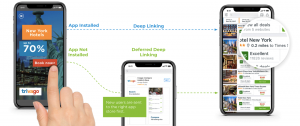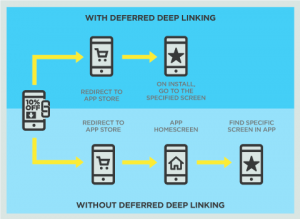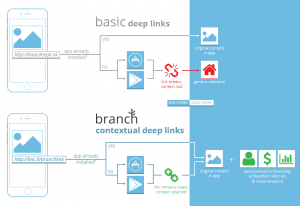Can you imagine that there are over 4 billion people in the world, who use their mobile devices on a daily basis? And most probably, you are one of them. Chances are that you have actually stumbled upon this article while doing Google search on your smartphone.
Thus, you might know how it feels, when you come across an ad offering the exclusive deal, click the link and… land at the irrelevant page. This is what I have experienced recently.
My friend is a great believer in internet banks, and has long persuaded me to join one. A few days ago, he got to me claiming that the bank he was using launched a promo campaign for newcomers. The special offer was an increased credit limit and up to 20% cashback on goods and services. He shared a link to the promo page and urged me to check it. As you might have guessed, upon clicking the link no miracle happened and I ran into an error page. My further steps were as follows – 1) going to the app store; 2) installing the app; 3) performing in-app search for relevant content, which happened to be quite a challenge as the app was not easily navigated. In most cases, this approach to building in-app links leads to the broken user experience, and as a result, losing a potential customer to a competitor. However, this can be easily avoided once the app developers enable deep linking.
A mobile application is no longer a simple program, but a full-fledged system for managing multimedia content, carrying out e-commerce activities, delivering news, etc. Nowadays, a mobile app is more like a website with numerous pages containing valuable material, so it becomes necessary to forward a customer to the page with a specific content or product item. This trend has also been recognized by search engines that allow mobile users to effortlessly surf the net for deep links and go directly to the intended app screen rather than a home page.
What is it in real terms?
Just like any website page on the internet is identified by a unique URL, so is the mobile app page. To specify any page within a mobile application the developer uses URI, a uniform resource identifier. Simply put, a deep link is based on this URI and acts as a predefined address, where specific in-app content is located.

Generally, there are two types of such links – basic and deferred. A basic link redirects a user to the desired screen of the app only if it is already installed on the smartphone – otherwise, it won’t work. As in the case with the internet banking app I described above, once a non-user clicks the basic deep link, their phone responds with an error page. A deferred deep link acts in a different way. If the application is not installed yet, the link offers to download the application from the app store first, and then redirects a user to the right section.

Recently, one more concept has emerged – a contextualdeep link. Invented by Branch, this term refers to an extended version of a deferred link. From the user’s perspective, the contextual deep link works in much the same way as the deferred link does. However, the contextual deep link has more functionality behind. It collects custom information about the users (like what is the source of the link? who shared it? is there a referral bonus? etc.), and as a result provides them with more personalized in-app content. With all that said, contextual deep linking contributes to positive user experience and facilitates onboarding.

Use cases
With all that said, you might be wondering how all this can help your mobile app engage more users, accelerate onboarding, and leverage your marketing efforts. Here are several common scenarios, where deep linking proves to be a powerful tool.
Retaining the existing users. Deep linking becomes an essential approach for promoting specific goods or services. Let’s say you are conducting the New Year giveaway campaign. To promote it and navigate the user directly to the app page offering bonuses, you can send a customized link through push notifications, email, or SMS, thus forcing the user to participate in it. Moreover, deep links work surprisingly fine for referral and affiliate programs.
Attracting new users. Similarly, deep link sharing can be used to get new users onboard. Suppose, you are a regular user of a particular music app – be it Spotify, Soundcloud, Apple Music, whatever. You are impressed with Rihanna’s new song and want to share it with a friend. You send the deep link via a messenger, inviting a new user to join the app and interact with the intended content. The key benefit here is that users take less steps to get to grips with your app, and as a result add more value to it.
Tracking user activity. Inherently, any deep link is a unique identifier for your particular app page or section. This is why it becomes especially valuable for data collection and analysis. By tracking link performance you can check the user activity and engagement, as well as the efficiency of your campaigns. You can then personalize user experience based on the findings.
Opt for a ready-made solution
As you can see, this approach is a real game changer in the world of mobile marketing. However, if you do not enjoy the right infrastructure to enable deep linking for your mobile application, you may consider the following specialized websites and services.
Branch
We have already mentioned Branch above as an inventor of the contextual deep linking concept, but they still have much more to offer. Branch is a linking platform that acts as an all-in-one tool for building custom links across various devices, channels, and platforms. Deep linking within Branch can be done in a few ways. If you are tech-savvy enough you can create links by integrating your Mobile or Web SDK, as well as an API. However, to make full use of the service, coding expertise is not a must. You can easily customize a link and specify the parameters like the distribution channel, sharing features, or tags from the user-friendly Dashboard. To ensure that the user clicking your Branch-generated link lands at a specific page smoothly, the platform uses an advanced algorithm offering 100% matching accuracy. Another killer feature of Branch is the analytics tool that provides you with all available data on the deep link performance.
Pricing here depends on the plan selected, and will cost you $59/month at average.
AppsFlyer
In fact, AppsFlyer is a platform that allows you to track your mobile marketing activities and collect attribution data. They have developed a deep linking solution called OneLink. With it, you can create a smart link that will work for different channels and environments. What’s more, OneLink is compatible with the latest versions of all OSs and doesn’t require setting any custom configurations. Largely based on the deferred technique, the platform generates a link that sends the user directly to the intended screen and provides contextually relevant experience. This customized onboarding is achieved due to the in-built analytics tool and the install detection feature. Also, OneLink makes it possible for the app owner to measure the performance of deep links placed in social media outlets like Instagram, Twitter, Quora, etc. It analyzes how much interaction these channels can deliver and help you design promotion campaigns specifically tailored to social media.
AppsFlyer offers a free trial for 30 days. But, if you decide on using the platform further, you need to contact the representatives for framing your custom plan.
In this article we considered two market leaders, however it doesn’t mean that your choice should be limited to them only. There are also Deeplink.me, Firebase, GetSocial, who offer a rich infrastructure for deep linking. With such services, enabling deep links won’t take much of your time and effort, but will certainly enhance your customer engagement, and help you achieve the goals that your application is intended to deliver. We always advice which solution to use for deep linking and if such functionality is necessary for your mobile app.

